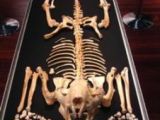Today, kangaroos are the giants of the Australian fauna. But once it was roamed by hippopotamus-sized beasts and cow-sized kangaroos.
Till now, scientists found incomplete bony remains of the extinct beasts of Australia, but now paleontologists have made a new sensational discovery: complete skeletons due to an ancestral death trap located in a cave in the Nullarbor Plain (South-central Australia).
The cave functioned as a trap in which the animals fell between 800,000 to 200,000 years ago. The mischance of the ancient animals brought an unexpected treasure for the scientists. Moreover, this spectacular cache of fossilized prehistoric "marsupial lions", giant wombats and kangaroos, owls and parrots points to the fact that humans might have killed the Australian megafauna 40,000 years ago, after entering the continent.
On the site, fossils of 69 species of mammals, birds and reptiles were found, including many complete skeletons and the first skeleton ever belonging to a marsupial lion (photo, image) and eight totally new kangaroo species.
The 20 to 70 m feet deep cave was found in 2002, but a team of the Western Australian Museum in Perth needed four years to dig and investigate the fossils. The tooth enamel investigation of 13 kangaroo species and one giant wombat revealed what they had been eating and thus the climate they lived in.
This seems to have been an arid one, very much like today's Nullarbor climate.
But the wider variety of herbivore species in the bone collection, 23 species of kangaroo, some able to climb trees, points that once Nullarbor vegetation must have been more varied than the few shrub species that punctuate the landscape today. "It's astonishing. I never imagined tree kangaroos on the Nullarbor Plain. Australia's arid zone was clearly once capable of supporting a much wider variety of browsing animals," says Tim Flannery of Macquarie University in Sydney. "Climate may play a smaller role in determining species diversity in Australia than has been thought," he says.
"The discovery that they survived in an arid environment undermines one of two popular theories for what killed them off - namely, that ice-age aridity was responsible. That leaves the second theory, which suggests that the giant kangaroos and wombats were wiped out by the actions of humans, either through habitat destruction or hunting", said Gavin Prideaux, lead researcher.
The same fact is supported but what the same team investigated in the Naracoorte caves in south-eastern Australia. Fossil evidences point that many megafauna species overpassed the recent ice ages till the last one, when people reached the continent. "We're never going to find a diprotodon [one of the largest extinct marsupials] with a spear in it, but this is as close as you can get to nailing the argument," says team member John Long of Museum Victoria in Melbourne.
Others do not agree. "You can say that a species was arid-adapted 200,000 years ago, but you can't then extrapolate to 40,000 years ago and say 'So humans must have done it,'" says Judith Field of the University of Sydney. "Archaeological finds from Cuddie Springs in south-eastern Australia, the only place where human and megafauna remains have been found in the same place, do not show that the animals were hunted." said Field. "Combinations of events, including the stress of the later, more severe ice ages, could have been responsible", she says.
Photo/Image: Western Australian Museum

 14 DAY TRIAL //
14 DAY TRIAL // 
